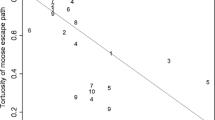Abstract
The anti-predator behavior of gelada baboons has been observed to consist of simple flight (i.e. they flee to cliffs after becoming alarmed by potential predators). However, active antipredator behavior was observed in a recently found gelada population in Arsi, Ethiopia. This population showed frequent active counter-attacks and severe mobbing at predators. Males fought domestic dogs on the plain and exhibited a systematic mobbing behavior towards a leopard on the cliff face to chase it off. These active anti-predator behaviors are the first confirmed reports on gelada baboons and may provide a useful insight for the understanding of the process of evolutionary adaptation to highland habitats by gelada baboons, as well as for the origin of this small southern population.
Similar content being viewed by others
References
Altmann, S. A.;Altmann, J. 1970.Baboon Ecology. Univ. of Chicago Press, Chicago.
Cowlishaw, G. 1994. Vulnerability to predation in baboon populations.Behaviour, 131 (3–4): 293–304.
Crook, J. H. 1966. Gelada baboon herd structure and movement: a comparative report.Symp. Zool. Soc. London, 18: 237–258.
Crook, J. H.;Aldrich-Blake, P. 1968. Ecological and behavioral contrasts between sympatric ground dwelling primates in Ethiopia.Folia Primatol., 8: 192–227.
Dunbar, R. I. M. 1977. Feeding ecology of gelada baboons: a preliminary report. In:Primate Ecology,Clutton-Brock,T. H. (ed.), Academic Press, London, pp. 251–273.
Dunbar, R. I. M. 1988.Primate Social Systems. Cornell Univ. Press, Ithaca.
Dunbar, R. I. M. 1993a. Social organization of the geladas. In:Theropithecus: The Rise and Fall of a Primates Genus,Jablonski,N. G. (ed.), Cambridge Univ. Press, Cambridge, pp. 425–440.
Dunbar, R. I. M. 1993b. Socioecology of the extinctTheropithecus: a modelling approach. In:Theropithecus: The Rise and Fall of a Primates Genus,Jablonski,N. G. (ed.), Cambridge Univ. Press, Cambridge, pp. 465–486.
Dunbar, R. I. M.;Dunbar, E. P. 1974. Ecological relations and niche separation between sympatric terrestrial primates in Ethiopia.Folia Primatol., 21: 36–60.
Isbell, L. A. 1994. Predation on primates: ecological patterns and evolutionary consequences.Evol. Anthropol., 3 (2): 61–71.
Iwamoto, T. 1979. Feeding ecology. In:Ecological and Sociological Studies of Gelada Baboons,Kawai,M. (ed.), Kodansha, Tokyo, pp. 280–330.
Iwamoto, T. 1993. The ecology ofTheropithecus gelada. In:Theropithecus: The Rise and Fall of a Primates Genus,Jablonski,N. G. (ed.), Cambridge Univ. Press, Cambridge, pp. 441–452.
Iwamoto, T.;Dunbar, R. I. M. 1983. Thermoregulation, habitat quality and the behavioural ecology of gelada baboons.J. Anim. Ecol., 52: 357–366.
Jablonski, N. G. 1993. The phylogeny ofTheropithecus. In:Theropithecus: The Rise and Fall of a Primates Genus,Jablonski,N. G. (ed.), Cambridge Univ. Press, Cambridge, pp. 209–224.
Kawai, M.;Dunbar, R. I. M.;Ohsawa, H. 1983. Social organization of gelada baboon: social units and definition.Primates, 24: 13–24.
Kawai, M.;Iwamoto, T. 1979. Nomadism and activities. In:Ecological and Sociological Studies of Gelada Baboons,Kawai,M. (ed.), Kodansha, Tokyo, pp. 251–278.
Mori, A.;Belay, G. 1990. The distribution of baboon species and a new population of gelada baboons along the Wabi-Shebeli river, Ethiopia.Primates, 31: 495–508.
Mori, A.; Iwamoto, T.; Bekele, A. 1997. A case of infanticide in a recently found gelada population in Arsi, Ethiopia.Primates, 38.
Ohsawa, H. 1979. The local gelada population and environment of the Gich area. In:Ecological and Sociological Studies of Gelada Baboons,Kawai,M. (ed.), Kodansha, Tokyo, pp. 3–45.
Yalden, D. W.;Largen, M. J.;Kock, D. 1977. Catalogue of the mammals of Ethiopia: 3. Primates.Monitore Zoologico Italiano (N. S. suppl. IX), 1: 1–52.
Author information
Authors and Affiliations
About this article
Cite this article
Iwamoto, T., Mori, A., Kawai, M. et al. Anti-predator behavior of gelada baboons. Primates 37, 389–397 (1996). https://doi.org/10.1007/BF02381374
Received:
Accepted:
Issue Date:
DOI: https://doi.org/10.1007/BF02381374




